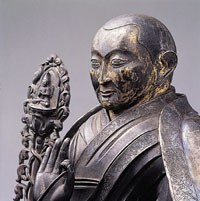In the history of the Qing Dynasty (1644-1911), two Dalai Lamas and one Panchen Erdeni went to Beijing for an andience with the emperor. They were the 5th Dalai Lama, who went in 1652, the ninth year of the reign of Qing Emperor Shunzhi, the 6th Panchen Erdeni, who went in 1780 or the 45th year of the reign of Qing emperor Qianlong, and the 13th Dalai Lama, who went in 1908, the 34th year of the reign of Qing Emperor Guangxu.

When the 5th Dalai Lama was invited to visit Beijing in 1652, Emperor Shunzhi granted him the honorific title of "the Dalai Lama", a fact that established the leading position of the Dalai Lama in Tibetan Buddhism. He was the first Tibetan religious leader who visited Beijing, symbolizing the fact that the Yellow Sect of Tibetan Buddhism had gained a dominant position in Tibet politically and religiously. Neither the Dalai Lama and Panchen Erdeni then visited Beijing for another 128 years.
During the reign of Qing emperor Kangxi, the emperor invited the 5th Panchen Erdeni to visit Beijing but he didn't travel because of trouble made by Diba Sanggyi Gyamco.
In June 1779 or the 44th year of the reign of Emperor Qianlong, the 6th Panchen Erdeni set out from Xigaze for the celebrations held to mark the 70th birthday of the Qing emperor. His visit contributed to improved ties between the Central Government and the local government of Tibet. Unfortunately, he died of smallpox in Beijing, at the tender age of 43, soon after his accomplishment of the historic mission. Emperor Qianlong was saddened by his death, and ordered the construction of Jinhuachen Pagoda at Huangsi Monastery in Beijing in his honor. Many of the cultural relics kept in the Palace Museum are related to the 6th Panchen Erdeni.
